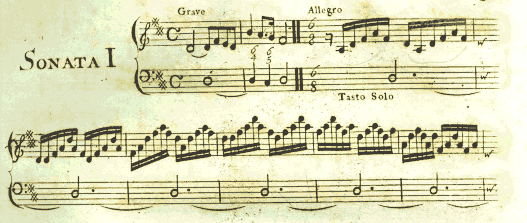Printed Music
Today, we learn to print music. The University of Houston's College of Engineering presents this series about the machines that make our civilization run, and the people whose ingenuity created them.
Here's a problem for you music lovers. How did we set music in the early days of printing? Gutenberg perfected movable type in the 1450s. He formed letters on the edges of narrow slivers of lead. Then he arranged them into racks called galleys. Printers inked the galleys and pressed them against paper.
That was hard enough when you only had to set a row of free floating letters. But the notes of music sit on lines. How do you set lines that run through the notes? The obvious solution was to print do a whole page at a time with a wood block. Block printing had gained popularity just before Gutenberg and it worked. But it lost every advantage of typesetting.
Gutenberg never tried to print music. But in 1455 he borrowed 800 guilders from Johann Fust. By 1457 he'd run that debt over 2000 guilders. Fust foreclosed before Gutenberg could turn a profit. He took over the new printing business and Gutenberg's assistant, Peter Shoeffer.
That same year, Fust and Shoeffer printed a Psalter with music in it. First they printed the text and three of the four lines used in Gregorian Chant. They put the 4th line, and the notes, in by hand. Other printers did the same thing.
That was clumsy business. Printers tried to find something simpler. One printed the words do, re, me fa, sol -- each in its vertical position. No lines at all! That was as hard to read as it was easy to print. It did not catch on.
A few years later, an Italian printer started setting music in two passes. First he printed lines. Then he made a second impression with the notes.
It was 1524 before a French printer, Pierre Haultin, cast notes in type with fragments of lines attached to them. He assembled them into a one-pass galley. By 1551, a family named Ballard had taken over that scheme. The men and women of the Ballard family defined the state of the art in music printing until the French Revolution.
As printing made written music available, music itself grew more complex. When we created full opera and oratorio scores, even the Ballards were driven back to a form of block printing. They reverted to copper-plate engraving by the early 1700s.
So printing technology drove the very complexities it struggled with. Music printing took music out of the cloisters and castles, and put it in homes. Like the radio you're listening to right now, printing spread the gift of music. And printing opened up the evolution of music itself.
I'm John Lienhard at the University of Houston, where we're interested in the way inventive minds work.
(Theme music)
Reese, G., Music in the Renaissance. New York: W.W. Norton & Company, Inc., 1959.
Heartz, D., A New Attaignant Book and the Beginnings of French Music Printing. J. Am. Musicological Soc., Vol. XIV, No. 1, Spring 1966, pp. 9-23. (Pierre Attaignant was an extremely important printer, who picked up Haultin's technique and first made wide use of it, even before the Ballard family.)
Cardwell, D.S.L., Turning Points in Western Technology. New York: Science History Publications, 1972, Chapter 1. (for a simple discussion of Gutenberg's technique.)
Raynor, H., A Social History of Music from the Middle Ages to Beethoven. New York: Taplinger Publishing Co., 1978, Chapter 8.
See also Encyclopaedia Britannica entries on Gutenberg, printing, and Ballard.
I'm grateful to Carol Lienhard for suggesting this topic, sketching it out, and locating much of the source material for it.
For more on Gutenberg, see Episodes 216, 753, 756, 894, and 992.
